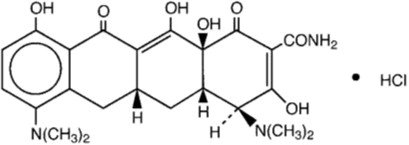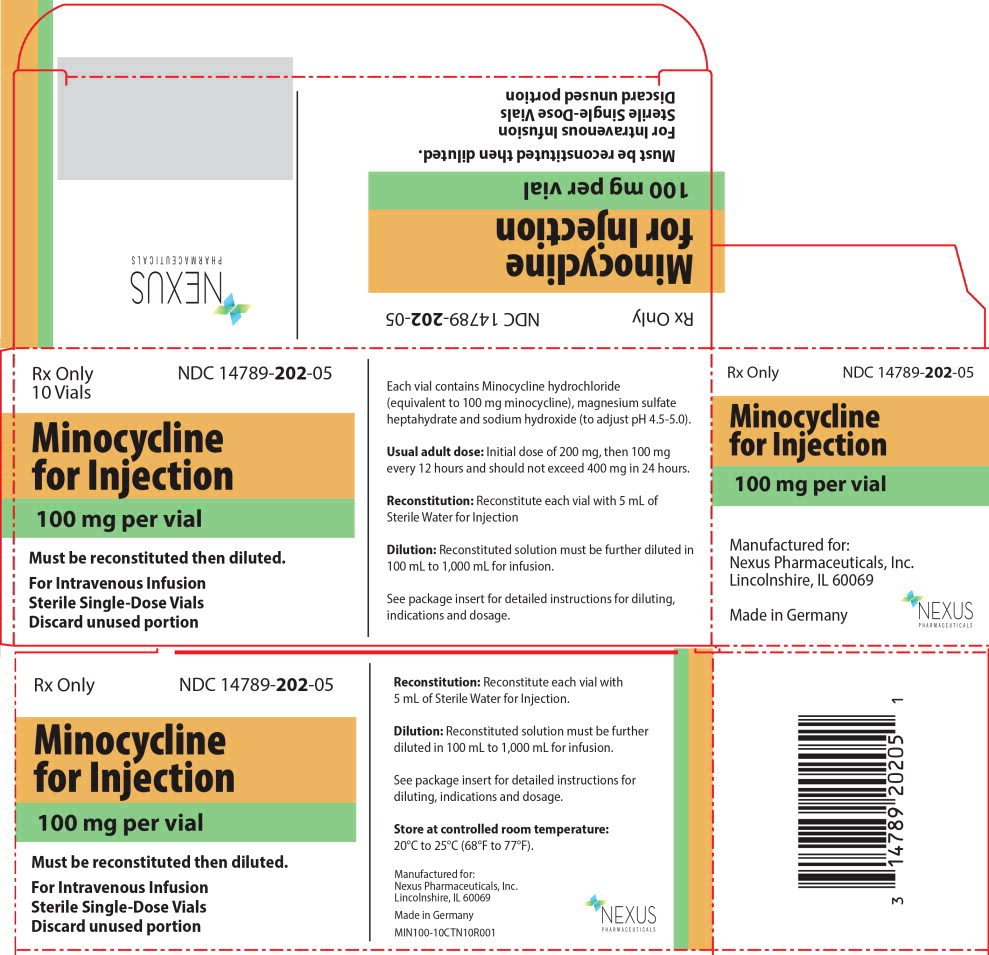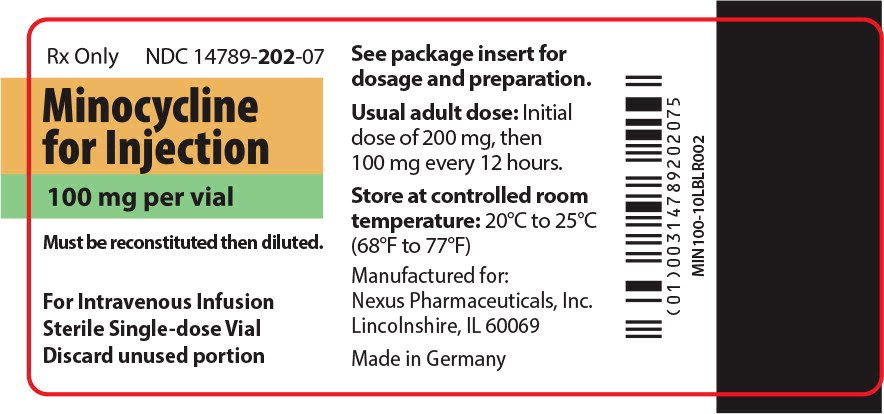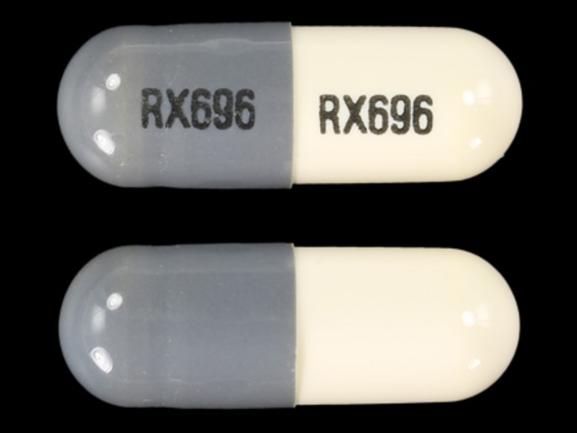Minocycline Injection: Package Insert / Prescribing Info
Package insert / product label
Generic name: minocycline hydrochloride
Dosage form: injection, powder, lyophilized, for solution
Drug class: Tetracyclines
Medically reviewed by Drugs.com. Last updated on Dec 11, 2024.
On This Page
Rx Only
To reduce the development of drug-resistant bacteria and maintain the effectiveness of Minocycline for Injection and other antibacterial drugs, Minocycline for Injection should be used only to treat or prevent infections that are proven or strongly suspected to be caused by bacteria.
Minocycline Injection Description
Minocycline for Injection is a sterile formulation of a semisynthetic derivative of tetracycline. The chemical name of minocycline is 4,7-Bis(dimethylamino)-1,4,4a,5,5a,6,11,12a-octahydro-3,10,12,12a- tetrahydroxy-1,11-dioxo-2-naphthacenecarboxamide monohydrochloride.
Its structural formula is:
C23H27N3O7 • HCl M.W. 493.94
Minocycline for Injection is supplied as a sterile yellow to amber lyophilized powder for intravenous infusion. Each vial contains minocycline HCl equivalent to 100 mg minocycline, 269 mg magnesium sulfate heptahydrate (2.2 mEq of magnesium) (an inactive ingredient) and sodium hydroxide (to adjust pH). When reconstituted with 5 mL of Sterile Water for Injection USP the pH ranges from 4.5 to 5.0.
Minocycline Injection - Clinical Pharmacology
Following a single-dose of minocycline 200 mg administered intravenously to 10 healthy male subjects, serum concentrations of minocycline ranged from 2.52 to 6.63 mcg/mL (average 4.18 mcg/mL) at the end of infusion and 0.82 to 2.64 mcg/mL (average 1.38 mcg/mL) after 12 hours. In a group of 5 healthy male subjects, serum concentrations of minocycline ranged from 1.4 to1.8 mcg/mL at the end of the dosing interval following administration of minocycline 100 mg every 12 hours for three days. When minocycline 200 mg once daily was administered for three days, serum concentrations of minocycline were approximately 1 mcg/mL at 24 hours. The serum elimination half-life of minocycline following administration of either minocycline 100 mg every 12 hours or 200 mg once daily was not significantly different and ranged from 15 to 23 hours. The serum elimination half-life of minocycline ranged from 11 to 16 hours in subjects with hepatic impairment (n=7) and 18 to 69 hours in subjects with renal impairment (n=5). In comparison, the serum elimination half-life of minocycline ranged from 11 to 17 hours following a single-dose dose of oral minocycline 200 mg in healthy subjects (n=12).
Microbiology
Mechanism of Action
The tetracyclines are primarily bacteriostatic and are thought to exert their antimicrobial effect by the inhibition of protein synthesis. The tetracyclines, including minocycline, have a similar antimicrobial spectrum of activity against a wide range of Gram-positive and Gram-negative bacteria. Cross-resistance of these bacteria to tetracyclines is common.
List of Microorganisms
Minocycline has been shown to be active against most isolates of the following bacteria, both in vitro and in clinical infections as described in the INDICATIONS AND USAGE section:
Gram-positive Bacteria
Bacillus anthracis
Listeria monocytogenes
Staphylococcus aureus
Streptococcus pneumoniae
Gram-negative Bacteria
Bartonella bacilliformis
Brucella species
Klebsiella granulomatis
Campylobacter fetus
Francisella tularensis
Vibrio cholerae
Yersinia pestis
Acinetobacter species
Enterobacter aerogenes
Escherichia coli
Haemophilus influenzae
Klebsiella species
Neisseria meningitidis
Shigella species
Other Microorganisms
Actinomyces species
Borrelia recurrentis
Chlamydophila psittaci
Chlamydia trachomatis
Clostridium species
Entamoeba species
Fusobacterium nucleatum subspecies fusiforme
Mycobacterium marinum
Mycoplasma pneumoniae
Propionibacterium acnes
Rickettsiae
Treponema pallidum subspecies pallidum
Treponema pallidum subspecies pertenue
Ureaplasma urealyticum
Indications and Usage for Minocycline Injection
Minocycline for Injection is indicated in the treatment of the following infections due to susceptible isolates of the designated bacteria:
Rocky Mountain spotted fever, typhus fever and the typhus group, Q fever, rickettsialpox and tick fevers caused by rickettsiae.
Respiratory tract infections caused by Mycoplasma pneumoniae.
Lymphogranuloma venereum caused by Chlamydia trachomatis.
Psittacosis (Ornithosis) due to Chlamydophila psittaci.
Trachoma caused by Chlamydia trachomatis, although the infectious agent is not always eliminated, as judged by immunofluorescence.
Inclusion conjunctivitis caused by Chlamydia trachomatis.
Nongonococcal urethritis, endocervical, or rectal infections in adults caused by Ureaplasma urealyticum or Chlamydia trachomatis.
Relapsing fever due to Borrelia recurrentis. Plague due to Yersinia pestis.
Tularemia due to Francisella tularensis.
Cholera caused by Vibrio cholerae.
Campylobacter fetus infections caused by Campylobacter fetus.
Brucellosis due to Brucella species (in conjunction with streptomycin).
Bartonellosis due to Bartonella bacilliformis.
Granuloma inguinale caused by Klebsiella granulomatis.
Minocycline is indicated for the treatment of infections caused by the following Gram-negative bacteria when bacteriologic testing indicates appropriate susceptibility to the drug:
Escherichia coli.
Enterobacter aerogenes.
Shigella species.
Acinetobacter species.
Respiratory tract infections caused by Haemophilus influenzae.
Respiratory tract and urinary tract infections caused by Klebsiella species.
Minocycline for Injection is indicated for the treatment of infections caused by the following Gram-positive bacteria when bacteriologic testing indicates appropriate susceptibility to the drug:
Upper respiratory tract infections caused by Streptococcus pneumoniae.
Skin and skin structure infections caused by Staphylococcus aureus (Note: Minocycline is not the drug of choice in the treatment of any type of staphylococcal infection.)
When penicillin is contraindicated, minocycline is an alternative drug in the treatment of the following infections:
Meningitis due to Neisseria meningitidis.
Syphilis caused by Treponema pallidum subspecies pallidum.
Yaws caused by Treponema pallidum subspecies pertenue.
Listeriosis due to Listeria monocytogenes.
Anthrax due to Bacillus anthracis.
Vincent's infection caused by Fusobacterium fusiforme.
Actinomycosis caused by Actinomyces israelii.
Infections caused by Clostridium species.
In acute intestinal amebiasis, minocycline may be a useful adjunct to amebicides.
In severe acne, minocycline may be useful adjunctive therapy.
To reduce the development of drug-resistant bacteria and maintain the effectiveness of Minocycline for Injection and other antibacterial drugs, Minocycline for Injection should be used only to treat or prevent infections that are proven or strongly suspected to be caused by susceptible bacteria. When culture and susceptibility information are available, they should be considered in selecting or modifying antibacterial therapy. In the absence of such data, local epidemiology and susceptibility patterns may contribute to the empiric selection of therapy.
Contraindications
This drug is contraindicated in persons who have shown hypersensitivity to any of the tetracyclines or to any of the components of the product formulation.
Warnings
Tooth Development
Minocycline for Injection, like other tetracycline-class antibacterials, can cause fetal harm when administered to a pregnant woman. If any tetracycline is used during pregnancy, or if the patient becomes pregnant while taking these drugs, the patient should be apprised of the potential hazard to the fetus. The use of drugs of the tetracycline class during tooth development (last half of pregnancy, infancy, and childhood to the age of 8 years) may cause permanent discoloration of the teeth (yellow-gray-brown).
This adverse reaction is more common during long-term use of the drugs but has been observed following repeated short-term courses. Enamel hypoplasia has also been reported. Tetracycline drugs, therefore, should not be used during tooth development unless other drugs are not likely to be effective or are contraindicated.
Skeletal Development
All tetracyclines form a stable calcium complex in any bone-forming tissue. A decrease in the fibula growth rate has been observed in premature human infants given oral tetracycline in doses of 25 mg/kg every six hours. This reaction was shown to be reversible when the drug was discontinued.
Results of animal studies indicate that tetracyclines cross the placenta, are found in fetal tissues, and can have toxic effects on the developing fetus (often related to retardation of skeletal development). Evidence of embryotoxicity has been noted in animals treated early in pregnancy.
Dermatologic Reaction
Drug Rash with Eosinophilia and Systemic Symptoms (DRESS) including fatal cases have been reported with minocycline use. If this syndrome is recognized, the drug should be discontinued immediately.
Anti-anabolic Action
The anti-anabolic action of the tetracyclines may cause an increase in BUN. While this is not a problem in those with normal renal function, in patients with significantly impaired function, higher serum levels of tetracycline may lead to azotemia, hyperphosphatemia, and acidosis. Under such conditions, monitoring of creatinine and BUN is recommended, and the total daily dosage should not exceed 200 mg in 24 hours (See DOSAGE AND ADMINISTRATION). If renal impairment exists, even usual oral or parenteral doses may lead to systemic accumulation of the drug and possible liver toxicity.
Photosensitivity
Photosensitivity manifested by an exaggerated sunburn reaction has been observed in some individuals taking tetracyclines. This has been reported with minocycline.
Central Nervous System Effects
Central nervous system side effects including light-headedness, dizziness or vertigo have been reported. Patients who experience these symptoms should be cautioned about driving vehicles or using hazardous machinery while on minocycline therapy. These symptoms may disappear during therapy and usually disappear rapidly when the drug is discontinued.
Clostridium difficile Associated Diarrhea
Clostridium difficile associated diarrhea (CDAD) has been reported with use of nearly all antibacterial agents, including minocycline, and may range in severity from mild diarrhea to fatal colitis. Treatment with antibacterial agents alters the normal flora of the colon leading to overgrowth of C. difficile.
C. difficile produces toxins A and B which contribute to the development of CDAD. Hypertoxin producing strains of C. difficile cause increased morbidity and mortality, as these infections can be refractory to antimicrobial therapy and may require colectomy. CDAD must be considered in all patients who present with diarrhea following antibacterial use. Careful medical history is necessary since CDAD has been reported to occur over two months after the administration of antibacterial agents.
If CDAD is suspected or confirmed, ongoing antibacterial use not directed against C. difficile may need to be discontinued. Appropriate fluid and electrolyte management, protein supplementation, antibacterial treatment of C. difficile, and surgical evaluation should be instituted as clinically indicated.
Intracranial Hypertension
Intracranial hypertension (IH, pseudotumor cerebri) has been associated with the use of tetracyclines including minocycline. Clinical manifestations of IH include headache, blurred vision, diplopia, and vision loss; papilledema can be found on fundoscopy. Women of childbearing age who are overweight or have a history of IH are at greater risk for developing tetracycline associated IH. Concomitant use of isotretinoin and minocycline should be avoided because isotretinoin is also known to cause pseudotumor cerebri.
Although IH typically resolves after discontinuation of treatment, the possibility for permanent visual loss exists. If visual disturbance occurs during treatment, prompt ophthalmologic evaluation is warranted. Since intracranial pressure can remain elevated for weeks after drug cessation patients should be monitored until they stabilize.
Precautions
General
As with other antibacterial preparations, use of this drug may result in overgrowth of nonsusceptible organisms, including fungi. If superinfection occurs, the antibacterial should be discontinued and appropriate therapy instituted.
Hepatotoxicity has been reported with minocycline; therefore, minocycline should be used with caution in patients with hepatic dysfunction and in conjunction with other hepatotoxic drugs.
Incision and drainage or other surgical procedures should be performed in conjunction with antibacterial therapy when indicated.
Minocycline for Injection contains magnesium sulfate heptahydrate (See DESCRIPTION). Because magnesium is excreted primarily by the kidney, serum levels of magnesium should be monitored in patients with renal impairment (See DOSAGE AND ADMINISTRATION).
Because Minocycline for Injection contains magnesium (See DESCRIPTION), close monitoring is recommended in patients with heart block or myocardial damage.
Prescribing Minocycline for Injection in the absence of a proven or strongly suspected bacterial infection or a prophylactic indication is unlikely to provide benefit to the patient and increases the risk of the development of drug-resistant bacteria.
Information for Patients
Patients should be counseled that antibacterial drugs including Minocycline for Injection should only be used to treat bacterial infections. They do not treat viral infections (e.g., the common cold). When Minocycline for Injection is prescribed to treat a bacterial infection, patients should be told that although it is common to feel better early in the course of therapy, the medication should be taken exactly as directed. Skipping doses or not completing the full course of therapy may (1) decrease the effectiveness of the immediate treatment and (2) increase the likelihood that bacteria will develop resistance and will not be treatable by Minocycline for Injection or other antibacterial drugs in the future.
Diarrhea is a common problem caused by antibacterials which usually ends when the antibacterial is discontinued. Sometimes after starting treatment with antibacterial drugs, patients can develop watery and bloody stools (with or without stomach cramps and fever) even as late as two or more months after having taken the last dose of the antibacterial. If this occurs, patients should contact their physician as soon as possible.
Laboratory Tests
Periodic laboratory evaluation of organ systems, including hematopoietic, renal and hepatic studies should be performed.
All patients with gonorrhea should have a serologic test for syphilis at the time of diagnosis. Patients treated with minocycline should have a follow-up serologic test for syphilis after 3 months.
Drug Interactions
Because tetracyclines have been shown to depress plasma prothrombin activity, patients who are on anticoagulant therapy may require downward adjustment of their anticoagulant dosage.
Since bacteriostatic drugs may interfere with the bactericidal action of penicillin, it is advisable to avoid giving tetracyclines in conjunction with penicillin.
The concurrent use of tetracyclines and methoxyflurane has been reported to result in fatal renal toxicity.
Concurrent use of tetracyclines with oral contraceptives may render oral contraceptives less effective.
Administration of isotretinoin should be avoided shortly before, during, and shortly after minocycline therapy. Each drug alone has been associated with pseudotumor cerebri (See PRECAUTIONS).
Increased risk of ergotism when ergot alkaloids or their derivatives are given with tetracyclines.
Minocycline for Injection contains magnesium sulfate heptahydrate (See DESCRIPTION). Potentially serious drug interactions may occur when intravenous magnesium sulfate heptahydrate is given concomitantly with CNS depressants, neuromuscular blocking agents and cardiac glycosides.
Drug/Laboratory Test Interactions
False elevations of urinary catecholamine levels may occur due to interference with the fluorescence test.
Carcinogenesis, Mutagenesis, Impairment of Fertility
Dietary administration of minocycline in long-term tumorigenicity studies in rats resulted in evidence of thyroid tumor production. Minocycline has also been found to produce thyroid hyperplasia in rats and dogs. In addition, there has been evidence of oncogenic activity in rats in studies with a related antibacterial, oxytetracycline (i.e., adrenal and pituitary tumors). Likewise, although mutagenicity studies of minocycline have not been conducted, positive results in in vitro mammalian cell assays (i.e., mouse lymphoma and Chinese hamster lung cells) have been reported for related antibacterials (tetracycline hydrochloride and oxytetracycline). Segment I (fertility and general reproduction) studies have provided evidence that minocycline impairs fertility in male rats.
Pregnancy
Teratogenic Effects (See WARNINGS)
All pregnancies have a background risk of birth defects, loss, or other adverse outcome regardless of drug exposure. There are no adequate and well-controlled studies on the use of minocycline in pregnant women. Minocycline, like other tetracycline-class antibacterials, crosses the placenta and may cause fetal harm when administered to a pregnant woman. Rare spontaneous reports of congenital anomalies including limb reduction have been reported in post-marketing experience. Only limited information is available regarding these reports; therefore, no conclusion on causal association can be established. If minocycline is used during pregnancy or if the patient becomes pregnant while taking this drug, the patient should be apprised of the potential hazard to the fetus.
Nursing Mothers
Tetracyclines are excreted in human milk. Because of the potential for serious adverse reactions in nursing infants from tetracyclines, a decision should be made whether to discontinue nursing or discontinue the drug, taking into account the importance of the drug to the mother. (See WARNINGS.)
Pediatric Use
Minocycline is not recommended for use in children below 8 years of age unless the expected benefits of therapy outweigh the risks (See WARNINGS).
Geriatric Use
Clinical studies of intravenous minocycline did not include sufficient numbers of subjects aged 65 and over to determine whether they respond differently from younger subjects. In general, dose selection for an elderly patient should be cautious, usually starting at the low end of the dosing range, reflecting the greater frequency of decreased hepatic, renal, or cardiac function, and of concomitant disease or other drug therapy (See WARNINGS, DOSAGE AND ADMINISTRATION).
Adverse Reactions/Side Effects
The following adverse reactions have been observed in patients receiving tetracyclines.
Body as a whole: Fever, and discoloration of secretions.
Gastrointestinal: Anorexia, nausea, vomiting, diarrhea, dyspepsia, stomatitis, glossitis, dysphagia, enamel hypoplasia, enterocolitis, pseudomembranous colitis, pancreatitis, inflammatory lesions (with monilial overgrowth) in the oral and anogenital regions. These reactions have been caused by both the oral and parenteral administration of tetracyclines.
Genitourinary: Vulvovaginitis.
Hepatic toxicity: Hyperbilirubinemia, hepatic cholestasis, increases in liver enzymes, fatal hepatic failure, and jaundice. Hepatitis, including autoimmune hepatitis, and liver failure have been reported (See PRECAUTIONS).
Skin: Alopecia, erythema nodosum, hyperpigmentation of nails, pruritus, toxic epidermal necrolysis, and vasculitis, maculopapular and erythematous rashes. Exfoliative dermatitis has been reported. Fixed drug eruptions have been reported. Lesions occurring on the glans penis have caused balanitis. Erythema multiforme and Stevens-Johnson syndrome have been reported. Photosensitivity is discussed above (See WARNINGS). Pigmentation of the skin and mucous membranes has been reported.
Local Reactions: Injection site erythema and injection site pain.
Respiratory: Cough, dyspnea, bronchospasm, exacerbation of asthma, and pneumonitis.
Renal toxicity: Interstitial nephritis. Elevations in BUN have been reported and are apparently dose related (See WARNINGS). Acute renal failure has been reported.
Musculoskeletal: Arthralgia, arthritis, bone discoloration, myalgia, joint stiffness, and joint swelling.
Hypersensitivity reactions: Urticaria, angioneurotic edema, polyarthralgia, anaphylaxis/anaphylactoid reaction (including shock and fatalities), anaphylactoid purpura, myocarditis, pericarditis, exacerbation of systemic lupus erythematosus, and pulmonary infiltrates with eosinophilia have been reported. A lupus-like syndrome and serum sickness-like reactions also have been reported.
Blood: Agranulocytosis, hemolytic anemia, thrombocytopenia, leukopenia, neutropenia, pancytopenia, and eosinophilia have been reported.
Central Nervous System: Convulsions, dizziness, hypesthesia, paresthesia, sedation, and vertigo. Pseudotumor cerebri (benign intracranial hypertension) in adults and bulging fontanels in infants (See PRECAUTIONS - General). Headache has also been reported.
Other: Thyroid cancer has been reported in the post-marketing setting in association with minocycline products. When minocycline therapy is given over prolonged periods, monitoring for signs of thyroid cancer should be considered. When given over prolonged periods, tetracyclines have been reported to produce brown-black microscopic discoloration of the thyroid gland. Cases of abnormal thyroid function have been reported.
Tooth discoloration in pediatric patients less than 8 years of age (See WARNINGS) and in adults has been reported.
Oral cavity discoloration (including tongue, lip, and gum) have been reported.
Tinnitus and decreased hearing have been reported in patients on Minocycline for Injection.
The following syndromes have been reported. In some cases involving these syndromes, death has been reported. As with other serious adverse reactions, if any of these syndromes are recognized, the drug should be discontinued immediately:
Hypersensitivity syndrome consisting of cutaneous reaction (such as rash or exfoliative dermatitis), eosinophilia, and one or more of the following: hepatitis, pneumonitis, nephritis, myocarditis, and pericarditis. Fever and lymphadenopathy may be present.
Lupus-like syndrome consisting of positive antinuclear antibody; arthralgia, arthritis, joint stiffness, or joint swelling; and one or more of the following: fever, myalgia, hepatitis, rash, and vasculitis.
Serum sickness-like syndrome consisting of fever; urticaria or rash; and arthralgia, arthritis, joint stiffness, or joint swelling. Eosinophilia may be present.
Minocycline for Injection contains magnesium sulfate heptahydrate (See DESCRIPTION). Adverse effects that may be associated with magnesium intoxication include flushing, sweating, hypotension, depressed reflexes, flaccid paralysis, hypothermia, circulatory collapse, cardiac and CNS depression proceeding to respiratory paralysis (See PRECAUTIONS).
Overdosage
The adverse events more commonly seen in overdose are dizziness, nausea, and vomiting.
No specific antidote for minocycline is known.
In case of overdosage, discontinue medication, treat symptomatically, and institute supportive measures. Minocycline is not removed in significant quantities by hemodialysis or peritoneal dialysis.
Minocycline Injection Dosage and Administration
THE USUAL DOSAGE AND FREQUENCY OF ADMINISTRATION OF MINOCYCLINE DIFFERS FROM THAT OF THE OTHER TETRACYCLINES. EXCEEDING THE RECOMMENDED DOSAGE MAY RESULT IN AN INCREASED INCIDENCE OF SIDE EFFECTS.
Note: Rapid administration is to be avoided. Parenteral therapy is indicated only when oral therapy is not adequate or tolerated. Oral therapy should be instituted as soon as possible. If intravenous therapy is given over prolonged periods of time, thrombophlebitis may result.
For Pediatric Patients above 8 years of Age
Usual pediatric dose: Initial dose of 4 mg/kg, then 2 mg/kg administered over 60 minutes every 12 hours, not to exceed the usual adult dose.
Adults
Usual adult dose: Initial dose of 200 mg, then 100 mg administered over 60 minutes every 12 hours and should not exceed 400 mg in 24 hours.
The lyophilized powder should be reconstituted with 5 mL Sterile Water for Injection USP and immediately further diluted in 100 mL to 1,000 mL with Sodium Chloride Injection USP, Dextrose Injection USP, or Dextrose and Sodium Chloride Injection USP, or in 250 mL to 1000 mL Lactated Ringer's Injection USP, but not with other solutions containing calcium because a precipitate may form especially in neutral and alkaline solutions.
When diluted in compatible solutions, the pH usually ranges from 4.5 to 6.0.
Once diluted into an intravenous bag, Minocycline for Injection may be stored either at room temperature for up to 4 hours or refrigerated at 2 to 8°C (36 to 46°F) for up to 24 hours. Any unused portions must be discarded after that period.
The pharmacokinetics of minocycline in patients with renal impairment (CLCR <80 mL/min) have not been fully characterized. Current data are insufficient to determine if a dosage adjustment is warranted. The total daily dosage should not exceed 200 mg in 24 hours in patients with renal impairment. However, due to the anti-anabolic effect of tetracyclines, BUN and creatinine should be monitored (See WARNINGS). Because Minocycline for Injection contains magnesium sulfate heptahydrate, serum levels of magnesium should be monitored in patients with renal impairment (See DESCRIPTION, PRECAUTIONS).
Parenteral drug products should be inspected visually for particulate matter and discoloration prior to administration, whenever solution and container permit.
Incompatibilities
Additives or other medications should not be added to Minocycline for Injection single-dose vials or infused simultaneously through the same intravenous line including Y-connectors. If the same intravenous line is used for sequential infusion of additional medications, the line should be flushed before and after infusion of Minocycline for Injection with Sodium Chloride Injection USP, Dextrose Injection USP, Dextrose and Sodium Chloride Injection USP, or Lactated Ringer's Injection USP.
How is Minocycline Injection supplied
Minocycline for Injection is supplied as 100 mg single-dose vials of sterile lyophilized powder.
NDC 14789-202-07: 100 mg single-dose vial
NDC 14789-202-05: units of 10 x 1 single-dose 100 mg vials
Store at Controlled Room Temperature 20° to 25°C (68° to 77°F).
ANIMAL PHARMACOLOGY AND TOXICOLOGY
Minocycline hydrochloride has been observed to cause a dark discoloration of the thyroid in experimental animals (rats, minipigs, dogs, and monkeys). In the rat, chronic treatment with minocycline hydrochloride has resulted in goiter accompanied by elevated radioactive iodine uptake and evidence of thyroid tumor production. Minocycline hydrochloride has also been found to produce thyroid hyperplasia in rats and dogs.
Manufactured for:
Nexus Pharmaceuticals, Inc.
Lincolnshire, IL 60069
Made in Germany
05/2021
MINPIR001
| MINOCYCLINE HYDROCHLORIDE
minocycline hydrochloride injection, powder, lyophilized, for solution |
||||||||||||||||||||
|
||||||||||||||||||||
|
||||||||||||||||||||
|
||||||||||||||||||||
|
||||||||||||||||||||
|
||||||||||||||||||||
| Labeler - Nexus Pharmaceuticals Inc. (620714787) |
| Establishment | |||
| Name | Address | ID/FEI | Business Operations |
|---|---|---|---|
| Nexus Pharmaceuticals Inc | 620714787 | ANALYSIS(14789-202) | |
Frequently asked questions
More about minocycline
- Check interactions
- Compare alternatives
- Pricing & coupons
- Reviews (564)
- Drug images
- Side effects
- Dosage information
- During pregnancy
- Drug class: tetracyclines
- Breastfeeding
- En español
Patient resources
Professional resources
- Minocycline monograph
- Minocycline (EENT) (AHFS Monograph)
- Minocycline (FDA)
- Minocycline Capsules (FDA)
- Minocycline Extended Release Tablets (FDA)
- Minocycline Tablets (FDA)
Other brands
Minocin, Emrosi, Ximino, Minocin for Injection, ... +2 more




